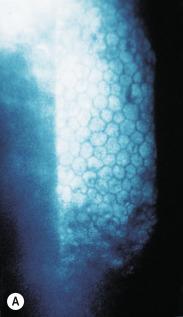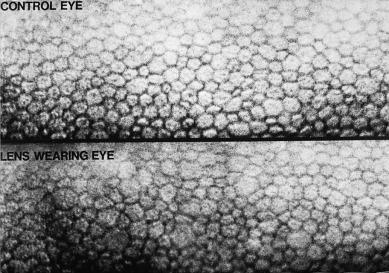Physical Address
304 North Cardinal St.
Dorchester Center, MA 02124
In the 1980s, a series of articles alerted contact lens practitioners to a potentially adverse effect of contact lens wear that could be observed in the cornea – namely, endothelial polymegethism ( Fig. 32.1 ). These observations were made soon after Zantos and Holden published their reports of transient changes in the endothelium induced by contact lenses (endothelial blebs; see Chapter 30 ). A picture of previously unknown acute and chronic lens-induced endothelial changes was emerging at that time. The critical role of the endothelium in maintaining corneal health was well understood, so reports of endothelial compromise were of considerable concern to eye care practitioners.
Since then, extensive clinical and laboratory research has been undertaken in an attempt to gain an appreciation of the nature and magnitude of the endothelial response to contact lens wear and the possible ramifications of these changes. As is often the case with scientific enquiry, differences of opinion have emerged, and some issues still remain unresolved. This chapter will examine the phenomenon of contact lens–induced endothelial polymegethism from a clinical and scientific perspective and will consider the debate on these changes being of any real clinical significance.
The variation in apparent size of cells in the endothelium (or in any other tissue layer) is expressed as the coefficient of variation of cell size (COV); this dimensionless ratio is calculated by dividing the standard deviation of the cell areas in a defined field by the arithmetic mean area of all cells in that field. The COV is a measure of the degree of endothelial polymegethism . (‘Polymegethism’ is derived from the Greek word ‘megethos’ meaning ‘size’; ‘poly’ means ‘many’ ).
Endothelial cells can also vary in shape. The term ‘endothelial polymorphism’ means ‘many shapes’, and the term ‘pleomorphism’ means ‘different shapes’. Individual endothelial cells can have anything from three to nine sides, although the majority of cells in a normal endothelium have six sides.
In the normal eye, the COV increases throughout life. Thus, any changes thought to be attributed to contact lens wear should be referenced against these normal age-related changes. Consequently, the term ‘endothelial polymegethism’, when discussed in this chapter in the context of an induced change, should generally be taken to mean a degree of change in excess of that expected for a given age.
The endothelium of a newborn baby has a very regular and uniform appearance, with all cells being almost exactly the same size and displaying classical hexagonality. In, say, a 25 year old – an age when contact lens wear might begin – the endothelium will typically display a low degree of polymegethism. The ratio of the diameter of the smallest cell to the largest cell that can be seen could be 1:5. In advanced cases of polymegethism, the ratio of smallest to largest cell can be as great as 1:20 ( Fig. 32.2 ). It is possible to make a qualitative assessment of the extent of polymegethism based on observation of the endothelial mosaic; techniques for assessing endothelial polymegethism are described under ‘Observation and grading’.

Reports of contact lens–induced endothelial polymegethism were first published by Schoessler and Woloschak in the early 1980s. These authors provided a convincing anecdotal demonstration of endothelial polymegethism in 10 patients who had worn polymethyl methacrylate (PMMA) lenses for at least 5 years. Subsequent researchers have quantitatively demonstrated increases in endothelial polymegethism associated with PMMA, rigid gas permeable and conventional hydrogel lenses. Silicone hydrogel and silicone elastomer lenses apparently do not induce significant levels of polymegethism.
Figure 32.3 is a compelling illustration of the effect of contact lens wear on the corneal endothelium; illustrated is a pair of endothelial photomicrographs of a patient who wore an extended-wear lens for 5 years in one eye only because of uniocular myopia. The bottom frame is the endothelium of the lens-wearing eye and the top frame is that of the fellow non-lens-wearing eye. A greater variation in endothelial cell size (polymegethism) is evident in the lens-wearing eye.

Hirst et al. also reported a substantially lower percentage of hexagonal cells in patients wearing PMMA contact lenses compared with matched non-lens-wearing control eyes. Such polymorphic changes are generally associated with changes in polymegethism.
To assess corneal endothelial cell morphometry in patients with diabetes who wear contact lenses, O’Donnell and Efron analysed images of the central corneal endothelium in a group of contact lens wearers with diabetes (type 1, n = 26; type 2, n = 4) and a group of age-matched contact lens–wearing control subjects without diabetes. Endothelial cell characteristics were similar for the two groups (p > 0.05), although four of the patients with diabetes (and none of the patients without diabetes) displayed folds in the endothelial mosaic.
As discussed in Chapter 31 , a number of authors have described an apparent reduction in central endothelial cell density in long-term contact lens wearers. Wiffen et al. explained that there is no actual loss of cells. Rather, there is a redistribution of cells from the centre to the mid-periphery of the cornea, resulting in a decrease in endothelial cell density of the central cornea and an increase in cell density of the mid-peripheral cornea. There is no presumed net change of the endothelial cell density of the entire cornea. As will become evident later in this chapter, the cell redistribution theory is an important consideration in the construction of models of the aetiology and pathology of age-related polymegethism versus contact lens–induced polymegethism.
Sweeney drew an anecdotal association between endothelial polymegethism and a condition which was termed ‘corneal exhaustion syndrome’. This is a condition in which patients who have worn hydrogel contact lenses for many years suddenly develop a severe intolerance to lens wear characterised by ocular discomfort, reduced vision, photophobia and an excessive oedema response. These patients also display a distorted endothelial mosaic and moderate to severe polymegethism.
Although the link between endothelial polymegethism and corneal exhaustion syndrome is not proven, it is plausible that chronic lens-induced hypoxia induces a number of pathological tissue changes (endothelial polymegethism being one of these), which can result in intolerance to lens wear.
Besides the possibility of corneal exhaustion syndrome, no other symptoms are associated with endothelial polymegethism.
Become a Clinical Tree membership for Full access and enjoy Unlimited articles
If you are a member. Log in here